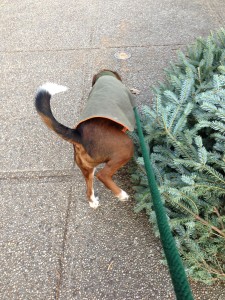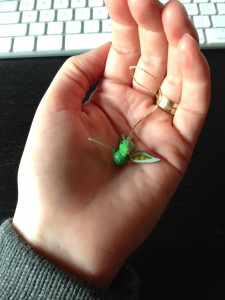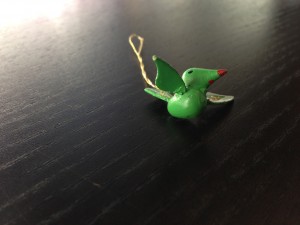
In early January, the sidewalks in my neighborhood are lined with discarded Christmas trees. It’s the collective holiday hangover trash, and quite frankly it makes me sad; the trees mark the moment of winter where all that is left are several cheerless months of cold and drudgery. My dog, however, goes apeshit over them. He loves to sniff them. He loves to pee on them. And, a couple of weeks ago, his Christmas tree habit led me to some unexpected psychological self-analysis.

On an early walk, as my dog lifted his leg on the eighth tree of the morning, I saw a tiny ornament clinging to its lowest branches. It was a green bird about the size of my thumbnail with black eyes, a small dot of red paint under its beak that looked almost like a smile, and yellow and white patterns running down its outstretched wings. Despite the smile, the bird looked so sad, forgotten there in the trash pile.
My first thought: “Oh, no no no. You don’t deserve this.” And I bent down, pulled it off of the branch, and cradled it in the palm of my hand.
My second thought: “I will save you.” And I zipped it into my coat pocket.
My next thought: “What the hell was that?” I’d just picked up trash from a dirty Brooklyn sidewalk and put it in my pocket. Worse: if my dog likes peeing on those trees, I’d bet the other dogs in the neighborhood do, too, which made it a probable urine-soaked piece of trash. Still, I couldn’t bring myself to throw it away.
When I got home, I did what any procrastinating science writer with a pile of deadlines would do: I put everything aside to try to figure out why I felt empathy for a piece of trash.

I had a hunch that my attraction to Freddie (yes, by this time my trash had a name) had to do with the fact that he (and a gender) was shaped like an animal. If the ornament had been a ball or a star, I doubt I would have even noticed it. After a fair amount of Googling embarrassingly unscientific phrases like “why we prefer animal shaped objects” and “why we like things with faces,” the closest work I could find was by Northwestern University psychologist Adam Waytz, who studies, in part, the psychology of anthropomorphism, or why we imbue objects or non-human animals with human-like characteristics, motivations, and emotions. Or, as Waytz describes it: “Giving a mind to a non-human entity.”
According to Waytz, there are three reasons why people give such agency to everything from technology to gods to bird-shaped Christmas ornaments.
The first is that when we see something that resembles a human, perhaps in how it looks or moves, we tend to treat it like a human. Even minimal cues, such as the presence of eyes, can prompt this psychological response.
The second is the motivation to understand the behavior of something by making it familiar. For humans, the most familiar object is, well, a human, which means we may try to understand general behavior in human terms, like deciding the car is in a bad mood when it won’t start in the morning or assuming the dog is getting us back for something when he misbehaves.
The third is the motivation for social connection, particularly for those who lack that connection with people. We’re social creatures, and making friends with objects or animals may be a coping mechanism for loneliness.
In my case, Waytz suspects that the first reason applies most (you could also argue for number three, as I’m a freelancer who faces hours of solitude each day, but let’s not. I have real friends, I swear!). I was seeing Freddie as human-like, which led to my feelings of empathy. Now, a bird is not a human, and a tiny wooden bird is further from it, but Freddie does have eyes and a mouth. Once I saw these features and aligned them with humanness, anthropomorphism manifested as me seeing the ornament as “a moral patient that has a right not to be harmed,” says Waytz. The bird had a right not to be thrown away, which made me want to rescue it. Its tiny size may have helped, Waytz adds, as we especially charge small animals or objects with emotion.

The moral part is important, adds Waytz: “Why this all matters at all and why we started studying this odd phenomenon of seeing human things in non-human states is because anthropomorphism has implications for morality.” He and his colleagues are currently exploring the opposite case of dehumanization, where people treat other people as either animals or objects as in cases of torture or abuse. They are also looking at the downstream consequences of humanizing an object. One might be that by thinking an object has a mind of its own, you make it capable of judging you.
Freddie has been on my desk ever since I brought him home and he isn’t going anywhere other than on my own Christmas tree later this year. Perhaps I fear the bird’s judgment, or that tossing him would reflect badly on my own morals. Or, maybe I’ve just grown to like him.
So, dear LWON readers, a question for you: have you ever had a similar experience with an inanimate object? If so, what were the circumstances and where is that object now?
**
Brooke Borel is a science writer in Brooklyn, New York. She is currently writing a book about bed bugs for the University of Chicago Press (2014). Find more of her work at www.brookeborel.com or follow her on Twitter @brookeborel.
Image Credits:
All photos by Brooke Borel
Sources/additional reading:
Interview with Adam Waytz, Northwestern University
Epley et al, “On Seeing Human: A Three-Factor Theory of Anthropomorphism,” Psychological Review 114:4 864-886 (2007)
Epley et al, “Creating Social Connection Through Inferential Reproduction,” Psychological Science 19:2 114-120 (2008)
Waytz et al, “Social Cognition Unbound: Insights Into Anthropomorphism and Dehumanization,” Current Directions in Psychological Science 19(1) 58-62 (2010)
Oh dear…I have possibly up to fifty or so inanimate objects with eyes that I have found or collected along the way. The Lincoln imp, netsuke rats, an acrylic monk, mingies…and should your bird need company I can provide a one-legged Santa on one ski, roughly about the same size as Freddie. I talk to them all.
You were attracted to you new friend because he resembled an animal. Why assume that the attraction was the result of automatic anthropomorphism? That seems a secondary action, the result of a more conscious decision to personalize the object and render it a projection of your own personality and becoming attached to the illusion. This podcast may give some insight to the issue:
http://www.onbeing.org/program/unfolding-language-unfolding-life/256
Rosie, are you going to invite me to tea so I can see your things with eyes?
I’ve noticed scientists doing the same thing with their cells, their molecules, and their galaxies. No eyes, but it’s the second motive, the need to understand something in its own reference frame. I love this. https://www.lastwordonnothing.com/2011/11/11/the-guys-talk/
I can identify with this as I have a similar hobby. (I call it a hobby because to call it an affliction would mean that there is something inherently wrong with me.)
When I buy things (which is not often anymore as we have adopted a minimalistic approach to the way in which we live), I look for objects that have small faults/flaws (which don’t affect their usefulness) and then buy them at full price, not expecting a discount.
My justification is twofold:
1. I’m giving said flawed object a good home where it will be loved and appreciated.
2. Said flawed object will feel worthy because I’ve paid full price for it.
But naming them? Now, that would be a step too far. ;.)
“Why do you feel sorry for it? It is just a lamp. And the new one is much better!” Is still one of my favourite commercials.
I also find it fascinating when anthropomorphization is applied not just to physical objects, but to abstract concepts. One example is Michael Pollen’s Botany of Desire where he utilizes human emotional descriptors to explain evolution. Things like, “this animal has cleverly gotten humans to serve its needs by developing certain traits that humans value” – giving consciousness to a random, but structured, process. The impacts of this are really interesting, especially since it’s one of the best ways to propagate misconceptions of scientific theories.
I once found a beautifully knitted child’s mitten on my walk home from school, I was in 6th grade. It was small, soft and green with two white stripes at the bottom of the mitten. It was as if it spoke to me saying, “please take me home, I’m cold.” So I took it home and asked my mother if I could put it on our Christmas tree as an ornament. There if hung, the tree wearing it as a mitten for one of its branches. The mitten is still hung on my tree every Christmas, I am 44 years old.
I wonder if the trash collectors had problems disposing of these Christmas trees: http://www.dface.co.uk/a-tree-is-for-life/.
Ann,
Great article although cows may not be vengeful…sheep certainly are whatever any scientist says.
Do drop in for tea.
I had recently moved to a small town in Virginia for a job at its newspaper. I had no friends in a five-hour radius. Some ducks lived in the grass behind my apartment. An early ice storm had hit. Outside my bedroom window, their quacking sounded desperate. I couldn’t sleep. I imagined what it must be like stuck out there with no shelter. So I got out of bed and dug out a big moving box and an extra blanket. I put on my coat and shoes and brought the stuff outside to set up a little coop for them against the building, kind of under the eaves, with the box on its side and the blanket on the bottom. “There,” I thought, and went back inside. In the morning I was like, “Did I put up a duck shanty last night?” Yes, loneliness can lead to anthropomorphism.
I once drove by a discarded stuffed animal on the side of a busy street while on my way to pick up my boyfriend. I could not stop thinking about that poor, lonely, abandoned stuffed animal. So after I picked up my boyfriend I drove right back to that spot, jumped out of my car and this ‘rescued’ the stuffed animal. I took it home, washed it three times and placed it on my rocking chair. Five years later it’s in the same place and now acts as a pillow or cuddle buddy for my cat.
Weird right?
I love all your stories! Duck shanties and one-legged santas and rescued stuffed animals!
And scrytech, yes, there are likely several ways to try to explain what happend to me with the Christmas ornament. But, I would point out that it was not a conscious decision to project my personality on the object. It was an automatic response where I saw the figure and immediately thought of it as a being with a mind that knew it was in the trash and didn’t want to be there. And, the fact that it was shaped like an animal helped drive the anthropomorphism (in fact, we also anthropomorphize non-human animals).
I think Keats said that a true poet needs to be able to identify so completely with the birds outside his window that he feels himself pecking seeds along with them. I’m not sure it’s “anthropomorphism” to identify with the experience of animals. Inanimate objects, fine, that’s obviously purely a matter of projection. But to feel empathy for the pain suffered by animals isn’t to think of them as human, but to see a continuum between your own animal nature and theirs. They communicate continuously, even though it’s through a limited language. They problem-solve and use tools (watch a squirrel get to a bird feeder or the video of crows cracking nuts under the wheels of passing cars). It’s compassion, not anthropomorphism. The more time I spend observing wild animals in my own ambit–my back yard, basically–the more I discern intelligence and conscious experience in their behavior. (OK, house sparrows are exempt. One must draw the line somewhere.) Yet to assume that all animals are somehow devoid of mental, and emotional, states is an act of hubris. To see signs of both in their behavior is the outcome of close and dispassionate observation, in my experience . . . and once you recognize this, the sense of identification you feel is rational, sensible and, well, humanizing for you, not the animal.
Children’s books do this all the time. “The Velveteen Rabbit”, “Corderoy” and more recently the movie “Toy Story”. Stories where inanimate objects become anthropomorphized when one is not looking.